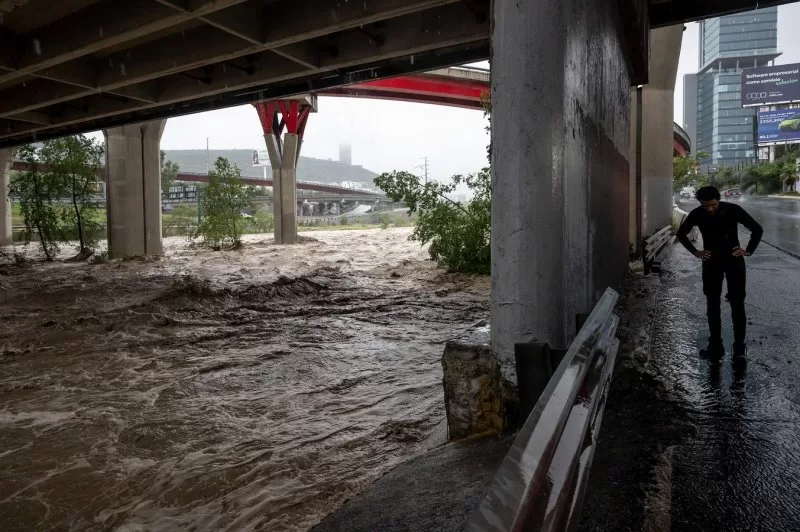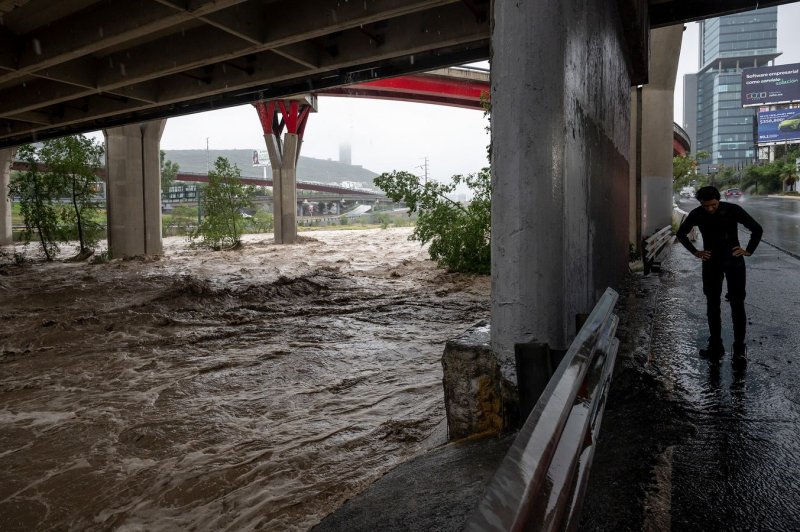1 of 2 | The Santa Catarina River from rainfall from the passage of the storm in Monterrey, Nuevo Leon, Mexico, Thursday. Photo by Miguel Sierra/EPA-EFE
June 20 (UPI) — The first named storm of this year’s Atlantic hurricane season made landfall over Mexico Thursday morning and is expected to pummel Texas with heavy rain into Friday.
Tropical Storm Alberto made landfall at about 7 a.m. CDT about 25 miles west of Tampico, Mexico, and about 255 miles south of Brownsville, Texas.
The storm was moving westward along the Gulf of Mexico before it moved inland. By mid-morning, the storm was downgraded to a tropical depression as it traveled about 18 mph and packed 35-mph winds through central Mexico.
Despite being downgraded, the National Hurrican Center warned Alberto still poses a threat to the region, due to heavy rain that can cause flooding and mudslides.
Texas Gov. Greg Abbott on Wednesday issued a severe weather disaster declaration for 51 counties in anticipation of the heavy rainfall, coastal flooding and tropical force winds the storm was likely to produce.
“I urge Texans in at risk-areas to remain weather aware and heed the guidance of state and local officials to keep themselves and their families safe,” Abbott said Wednesday.
The National Weather Service on Thursday reported winds above 50 mph in the Galveston Bay area and and rainfall totals of about 2 to 7 inches across the coastal bend.
AccuWeather predicted rainfall totals of about 8 to 12 inches for the Big Bend area of Texas, and winds could reach speeds of up to 60 mph.
Storm surge along the coast of northeastern Mexico, Texas and western Louisiana peaked at 1 to 3 feet, according to AccuWeather, but the Houston and Galveston areas could see up to 6 feet in some low-lying areas until conditions ease into Friday.
Footage from CNN on Thursday morning showed the coastal town of Surfside Beach in Texas besieged by high waves crashing over a seawall and flooding residential areas.
Surfside Mayor Gregg Bisso said the cleanup effort is on hold after the high water levels made it unsafe, but recovery will resume once the water has subsided enough.
The city also limited access to Follet’s Island’s west end where about 100 homes were left without power in the wake of the storm. Only residents, contractors and people with rental agreements can access that side of the island.
Access to the beach is also prohibited.
“We haven’t even been able to get down on the beach yet to take a look at it, to see what it’s what it looks like, see how much damage we’ve had to our dunes and things like that,” Bisso said. “As we get down there, we’ll be able to assess the situation a lot better.”
In San Antonio, CPS Energy said about 1,400 of its 938,000 customers were left without power on Thursday morning.
The White House on Thursday said President Joe Biden was briefed on Alberto, as well as on wildfires in the southwest United States and extreme heat across the rest of the country.
In Mexico, meanwhile, there were four confirmed deaths related to Alberto as of Thursday.
Officials in the northeastern state of Nuevo León said a man died early Thursday morning when he was trying to repair a window on his home.
Severe weather conditions caused by Alberto also claimed the lives of three minors on Wednesday. One 16-year-old boy drowned in Monterrey when he entered the La Silla River to try to retrieve a ball.
The other two minors were killed by electrocution from a light pole while riding their bikes in Pino Suárez.
Residents in northeastern Mexico, however, see Alberto as also bringing much needed rain to the region, which for over a year has suffered from severe drought.
Erick Teódulo Cavazos Cavazos, director of Civil Protection of Nuevo León, told local media on Thursday that rains from Alberto are resupplying dams such as La Boca and El Cuchillo.
“We have to wait for the figures from El Cuchillo, but everything that comes from the Santa Catarina River and the La Silla River goes to El Cuchillo,” he said. “We also had a dam that was in a water crisis in the entire Linares region, in the municipality of Cerro Prieto, water is entering.”
AccuWeather also is keeping an eye on a possible second tropical storm system that could form this weekend and once again hammer notheastern Mexico and southern Texas.
“There is a moderate chance for development from June 21-23 across a similar area in the Gulf of Mexico,” said AccuWeather Meteorologist Andrew Kienzle. “This feature will need to be watched for possible impacts on the Gulf coasts of the United States and Mexico this weekend into early next week.”

